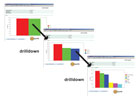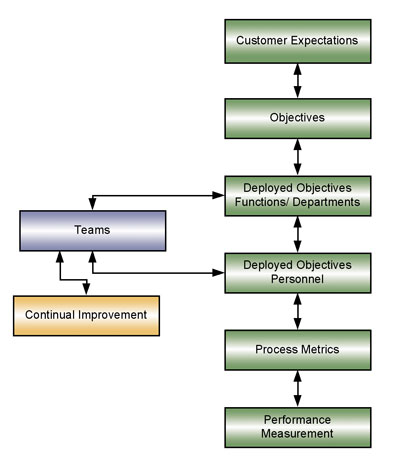
Most organizations are still trying to do it all using disparate manual and software systems. This leads to waste because of losses in system effectiveness and efficiency. These functions have to be linked within their own site and to different entities in the organization.
The enterprise quality management system restricts the focus of the software and its functionalities to actual quality management systems. Today, most organizations are working with multiple standards or methodologies, including environmental management systems, occupational health and safety systems, and Malcolm Baldrige. The enterprise quality management system of yesteryear will evolve into the enterprise integrated management system of the future.

Enterprise Integrated Management
There are linkage requirements in an enterprise integrated management system between the common areas of functionality across the entities of an enterprise. Here are a few:• Customers, objectives, performance measurement and continual improvement
• Customer expectations, company objectives, personal objectives, teams and continual improvement
• Products, new product development, Failure Mode Effect Analyses (FMEAs), control plans and work instructions
• Products, gages, and calibration and measurement systems analysis
• Process maps, process flows, process measurables and improvement
Each functionality should handle the multiple requirements of quality management systems (QMS), environmental management systems (EMS) or Malcolm Baldrige. For example, the documentation functionality should be able to work with quality, environmental, health and safety, and other documents irrespective of its origin or purpose.
Each functionality should handle how the enterprise is organized-corporate, business units, plants, departments and product groups-and be able to handle transactions in multiple languages. Functionalities should reflect how enterprises share documentation between different entities. They must consider the concept of documentation integration and flexibility described above, but at the same time must be able to handle the issue of standardization vs. uniqueness that is fundamental to how an enterprise works. To further the concept of the enterprise, "entity" is used to describe the constituent parts of an enterprise.
When the three concepts-integration of multiple standards, enterprise thinking and linkages-are applied to the functionalities of an enterprise integrated management system, the organization saves money.
For example, a product manager in the United States tries to access documentation for the plant in Spain to understand the sales for a product that is sold there. Within seconds, the enterprise integrated management system should allow the manager to access this data-as long as security allows it-allowing an important business decision or project report to move forward. This availability of information may save hours that would ordinarily be spent finding the correct person to access the data or dealing with the mistake of making of a decision without the correct data.
Another example is a plant in China trying to understand the variability in a piece of testing equipment used in many of their plants around the world. The plant in China should be able to access at will the measurement system analysis (MSA) studies from different plants for this family of testing equipment. This information accessed by the plant in China provides them with the information they need to understand that their testing equipment needed improvements.
Hence, these three concepts-integration of multiple standards, enterprise thinking and linkages-save time and provide value in running the business.
These concepts apply to the different functionalities present in an enterprise quality management system. Common functionalities are in the following areas:
Documentation. The documentation of the organization should be readily accessible whether it is stratified into entities-business unit (BU), plant, department or product group-or organized into levels-policies, procedures, FMEAs, PPAPs and customers.
Business metrics. Business metrics between the corporate, BU, plant, product groups and departments should be linked. In other words, the downtime for the enterprise should be able to be decomposed into constituent parts throughout the stratification. Also, there should be linkages between result and process metrics.
Internal audits. Any type of internal audit should be managed by one or many sites. Also, depending on security level, the top-most entity should be able to monitor the audits, results and overall schedule for the corporation.
Corrective actions. Corrective actions should be available in any format that the customer or organization wants, including CAR, 8-D, PRR or 5-Why. Corrective actions should be available for audits, customer complaints, internal issues and continual improvement. Corrective actions should be linked by product family, customers and entities.
Continual improvement. Continual improvement should be linked to metrics, corrective action, new product development issues and other improvement opportunities. It should allow for meetings to be scheduled and documented using meeting minutes, action plans, team metrics, project planning and corrective actions.
Policy deployment. Top management objectives should be linked to entity objectives-BU, plant and departmental. Further, entity objectives should be assigned to personnel in the organization with metrics for accountability.
Process management. Process maps and process flows in the enterprise should be documented and managed by the enterprise integrated management system software.
New product development launches including preventive tools. New product development should use Gantt charts with the same functionality that project planning software offers. This software should allow assignment of responsibilities to the entities in the organization, including its suppliers. This software should make Design Failure Mode and Effects Analysis test plans, manufacturing process flow, Process Failure Mode and Effects Analysis control plans and quality check sheets available for viewing. The software should have prevention-based tools, and it links product design, process engineering and the plant floor.
Measurement systems analysis. The software should allow measurement systems analysis including linearity, bias, gage repeatability and reproducibility, and stability, as well as calibrations to be conducted within any entity in the organization. Gage variability studies should be available by family of gages and available across the enterprise.
Total productive maintenance. The enterprise quality management system should integrate preventive and predictive maintenance techniques for the processes in the manufacturing process flow just like any good product development software would.
Statistical process control. The software should monitor real-life process measurement and offer triggers and alarms linked to the control plan using the product development software module.
Training. The enterprise integrated management system should capture the training needs analysis, training schedules, and training and competency records for all employees.
The quality software market will consolidate to a few players that support enterprise integrated management system functionality as happened with CRM or ERP software. This change will happen as customers gain more awareness and realize the savings potential and benefits of an enterprise integrated management system. Q
Tech Tips
• Each functionality should handle how the enterprise is organized-corporate, business units, plants, departments and product groups-and be able to handle transactions in multiple languages.• Integration of multiple standards, enterprise thinking, and linkages save time and provide value in running the business.
• ERP, CRM and enterprise integrated management system software packages all need to communicate with each other.